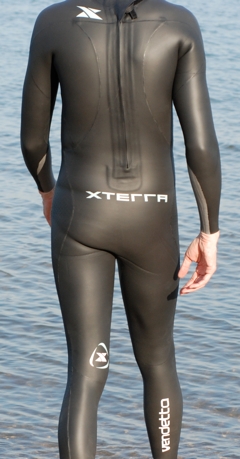
You Could Try One
How We Learn
Swim
Bike
Run
Open Water Swims
Warmup/Cooldown
Wetsuits
Tech Wear & Tri Suits
Rules
Stretching
Strength Training
Nutrition Basics
Losing Weight
Nutrition For Athletes
Race Nutrition
Race Lengths
Training, Tapering
Cramps
Creaky Knees
Gadgets
Running Shoes
Gear Checklist
Race Day
Picks & Pans
Warning Label
Marathon (the song)
Also Try Feldenkrais

Wetsuits
Wetsuits serve multiple purposes. They keep you warm, they allow you to slip through the water better, and they add some buoyancy (you know, sexy waterwings). Actually, it's more than buoyancy. It tends to be more buoyant on your legs than on your chest, and that helps to keep you streamlined in the water with your legs near the surface instead of hanging down creating resistance. We all want to swim this way regardless of whether or not you're wearing a suit. But the suit makes it easier and counteracts the bad effects of sighting in open water. (Head comes up to look. Feet go down. Drag increases. With a wetsuit on, the extra buoyancy in the legs helps keep them up.)
When I first bought a wetsuit (mid 1990s) I decided to get a "long john" (sleeveless) version. It provides adequate warmth for most lakes while leaving the arms free for the stroke. But it was nearly impossible to get off quickly (which matters when you're racing) and when I went swimming in cold, cold, cold Lake Michigan, oh the pain of unprotected arms. (Sometimes it's balmy, but sometimes it just freezing.)
Wetsuits have improved enormously in the last 15 years, and they've gotten much better at making the shoulder area flexible for swimming. (They use much thinner material in the shoulder joint.) So I decided it was time for a new suit and spent a summer going into stores and putting on wetsuits and pretty much making myself crazy trying to find something I liked. (Trying on wetsuits is a long difficult process. Most of them can take forever to get into. They need to be form fitting, so they're very, very tight. I have memories of standing there with my arm out while the poor salesman tried without much luck to slide the suit up my arms. So by the time you've tried a few on, you're soaked in Suit Juice and sweat, and you're just exhausted.)
Then a couple of friends recommended Xterra. That's a company in California that specializes in wetsuits. They only sell direct (you know, like Dell used to do). They figure by cutting out the middlemen they can offer more bang for the buck. I was nervous about buying something without trying it on, but they've got an excellent returns policy. So I went ahead and ordered one. And ended up really happy with the decision, for a couple of reasons. First, it's a really nice suit, comfortable and incredibly slippery. I remember the first time I swam in it, every stroke seemed to have more power behind it because the suit was sliding through the water so nicely. It's also the easiest suit I've ever gotten into. Xterra recommends using plastic bags over the feet and hands to slide into the suit, and that works like a charm. I don't even bother with Suit Juice. They also claimed the suit would just roll right off. I was ecstatic at the idea. But that didn't work for me. I ended up cutting a couple of inches off the bottom of each leg in order to make it easier to remove. But you can do that without ruining the suit. (Though it does end the warranty and you have to know what you're doing and be careful. More on that and getting out of wetsuits below.) So now I'm quite happy with it.
The other reason I love the suit is I ended up getting a discount on it. I was talking with somebody at Xterra, and mentioned that I was coaching triathlon. Next thing you know I'm talking to their "Sponsored Athletes" coordinator and they're asking if I'd like to be one. Well when you're an old geezer in his 60s and some company is offering to sponsor you, it's a funny feeling. Actually they're not offering me any money, but they gave me a great discount on the suit and offered to give anyone I sent their way a discount. I wasn't expecting much, but when they sent me the details sheet it was as much as 50% off. I guess they figure since they don't sell to stores, this is a way to get people in the door. But it's a wholesale price! So you know when you're on the ubiquitous order processing screen and they've got a place for a discount code and you haven't got one and you wonder what you're missing out on and you feel like it's not fair because somebody's getting a discount and you know darn well you're not going to get it? Well, I can give you a code. It's
CO-BHCOACH
That's obviously a code with my name in it, but they haven't offered me anything if anyone uses it. Still, in some sense my recommendation has been bought, but my impressions of the company really are incredibly positive so far. (If you give them a shot and are in any way not thrilled, let me know.) So if you've been looking for a wetsuit click on the logo below and see if they've got something that fits your needs. What have you got to lose?

Getting In & Out of Wet Suits
One thing you've got to keep in mind when handling wet suits is that they can be punctured. They're built to have a slippery as opposed to indestructible surface. If you grab the material with your fingertips facing into the surface and you've got fingernails, you're going to end up with punctures. Grab the material with the sides or flats of your fingers. Pulling on a wet suit is not easy and you should be willing to spend time at it. Wrapping your foot or arm in a plastic bag like you get at the grocery store works really well. But then you need to keep pulling it up for a while. Pull the suit as high up into your crotch as you can. It's a flexible material so you need to do it in stages. Start at the knees and pull that material up. Move up a few inches. Pull again. Up a few inches. Pull, pull, pull. All the while avoiding fingertips. Same for the arms. Move as much material as you can up into the shoulder area. If you'll move material from your tummy up into your chest and arms up into your shoulders, you'll give the suit the maximum flexibility as you're stroking.
Getting out of a wet suit is an art form you'll need to practice. The first time I ever removed a wet suit in a race it cost me several minutes with the clock ticking away. (I hadn't practiced beforehand.) You should begin the process of getting out the second you're out of the water. Grab the Velcro that holds the neck in back and pull. Grab the strap that hangs down in back and unzip. Pull your arms out of the sleeves. (Xterra describes a specific motion that works quite well for their suits.) If you've got sleeves, tuck your cap and goggles in one of the sleeves so you've got your hands free. Roll the top of the wet suit down so it's hanging from your waste. All this should be done as you hurry to the transition area. When you get to transition, roll it down over the thighs so the only thing covered is your shins. What I'm about to describe Xterra doesn't recommend because they don't want stones or what-not getting embedded in the wet suit, but the most common next move is to stand on the wet suit holding it down with one foot and jerk the other foot up. This will usually get you half way there. Readjust the foot that's holding the suit down so it's as close as possible on the other leg's material and then jerk again. Usually that will do it. There are demonstrations of this on the web. Xterra instead recommends just rolling it off as far as possible and then slipping a thumb between the wet suit and skin on each side and just sliding it off. I figured it might be faster using the step and jerk approach on the Xterra suit (being careful not to do this on a gravel surface but a towel over grass). Anyhow, step and jerk didn't work as well on the Xterra as sliding it off with the thumbs. Xterra doesn't recommend using a lubricant, and I don't anymore. But that's the industry standard approach. There are products like Suit Juice and Body Glide which will make a suit easier to get out of.
Finally a few words about cutting a strip off the bottom of the legs. I've done this with two suits now and each time I was glad I did. Made it easier to get off and didn't harm the suits usefulness to me. However there's a seam you need to be aware of. The bottom few inches of the seam on the inside will be supported by additional bonding fabric to hold it together. If you cut above that bonding fabric, the seam could start to unravel. Only remove one or two inches from the bottom. Leave at least an inch of bonding fabric inside the suit.
The most important message here is to practice removing your suit until it happens in a matter of seconds. Losing minutes to the process and having those minutes part of your race time is utterly sad and avoidable.
And if there are people available as you get out of the water to help you get the suit off, say yes.